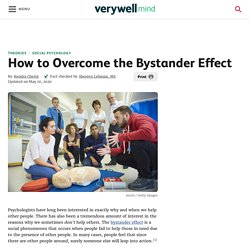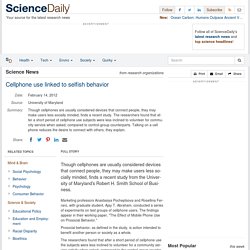

According to the Bystander Effect theory, individuals are less likely to take action and offer help to someone in need when there are more people around.
This theory was first demonstrated by John M. Darley and Bibb Latané in 1968.
Untitled. Bystander Effect – APA Dictionary of Psychology. Bystander Effect. What is the Bystander Effect?
Kitty Genovese. The Kitty Genovese murder in Queens, New York, in 1964 is one of the most famous murder cases to come out of New York City and into the national spotlight.

What propelled it wasn’t the crime or the investigation, but the press coverage that alleged the murder had many witnesses who refused to come to the Kitty Genovese’s defense. This has been disproved over time, but not before it became part of the accepted lore of the crime. Kitty Genovese was returning from work home at around 2:30 a.m. on March 13, 1964, when she was approached by a man with a knife. Genovese ran toward her apartment building front door, and the man grabbed her and stabbed her while she screamed. A neighbor, Robert Mozer, yelled out his window, “Let that girl alone!” Genovese, seriously injured, crawled to the rear of her apartment building, out of the view of any possible witnesses.
She was found by neighbor Sophia Farrar, who screamed for someone to call the police. Kitty Genovese. The Kitty Genovese Murder and the Social Psychology of Helping The Parable of the 38 Witnesses. 10 Notorious Cases of the Bystander Effect. The Bystander Effect. THE BYSTANDER EFFECT. Bystander Effect Experiment in School. The Good Samaritan. What Is the Bystander Effect? If you witnessed an emergency happening right before your eyes, you would certainly take some sort of action to help the person in trouble, right?

While we might all like to believe that this is true, psychologists suggest that whether or not you intervene might depend upon the number of other witnesses present. Why does the Bystander Effect Occur? Darley & Latane (1968) Ethics Defined: Diffusion of Responsibility. Pluralistic Ignorance: Definition. What is EVALUATION APPREHENSION MODEL? What does EVALUATION APPREHENSION MODEL mean? Other Explanations. The bystander effect is complicated. Darley and Latane (1968) Controversies Presentation.
How to Overcome the Bystander Effect. Psychologists have long been interested in exactly why and when we help other people.

There has also been a tremendous amount of interest in the reasons why we sometimes don't help others. The bystander effect is a social phenomenon that occurs when people fail to help those in need due to the presence of other people. In many cases, people feel that since there are other people around, surely someone else will leap into action.1 While the bystander effect can have a negative impact on prosocial behavior, altruism and heroism, researchers have identified a number of different factors that can help people overcome this tendency and increase the likelihood that they will engage in helping behaviors.2 Some of these include: Witnessing Helping Behavior Sometimes just seeing other people doing something kind or helpful makes us more willing to help others. Imagine that you are walking into a large department store.
Being Observant Being Skilled and Knowledgeable Guilt Feeling Good. Reducing the Bystander Effect. As discussed, there are a number of factors that magnify the Bystander Effect.

Fortunately, there are also a number of factors that weaken it. Once again, factors can be divided into characteristics of the situation, and of the people. Situational characteristics Dangers of the incident The perceived danger of intervening in a critical situation has the greatest influence in reducing the Bystander Effect. Several explanations could account for the role of perceived danger. Most fundamentally, the arousal: cost–reward model suggests that taking action is a response to the physiological arousal engendered by a critical situation, and that.
Helping Kids Overcome the Bystander Effect. Newscasters love to share stories of kids as young as three years old calling 911 to save a parent’s life.

These stories bear out what research has shown us: Very young children have a propensity to be kind and helpful. Starting as early as 18 months, studies show, toddlers spontaneously help an adult who is unable to pick up something he dropped or finds himself in a similarly tricky situation. Being kind at a cost to themselves makes two year olds happy, and three year olds who cooperate on a task share rewards even when they don’t have to. Counteracting the Bystander Effect. The Bystander Effect In The Cellphone Age. It was the start of the third inning between two teams in the Pony division of the Jamaica Plain Regan Youth League.

The pitcher for the JP Seafood Pirates was warming up at Murphy Field, and his teammates were throwing grounders to each other. Suddenly, the catcher remarked, “Yo, there’s a fire going on!” It was a bench clearing moment. Members of the Matt Gore Real Estate Orioles joined their rivals in right field, gazing in disbelief as vivid orange flames shot off the roof of a triple-decker, some 300 feet down Child Street. A coach and other adults called 911, and parents abandoned the game and rushed toward the scene. When my husband first ran toward the burning house, he noticed a passerby taking pictures.
There were no emergency vehicles there yet. A bewildered woman, wondering why an agitated stranger was telling her to leave, opened the door to the first floor apartment. “I kept telling her, ‘You’ve got to get out right now,’ ” my husband said. Cellphone use linked to selfish behavior. Though cellphones are usually considered devices that connect people, they may make users less socially minded, finds a recent study from the University of Maryland's Robert H.

Smith School of Business. Marketing professors Anastasiya Pocheptsova and Rosellina Ferraro, with graduate student, Ajay T. Abraham, conducted a series of experiments on test groups of cellphone users. The findings appear in their working paper, "The Effect of Mobile Phone Use on Prosocial Behavior. " Prosocial behavior, as defined in the study, is action intended to benefit another person or society as a whole. Bystander Effect and Handphones. Conclusion.